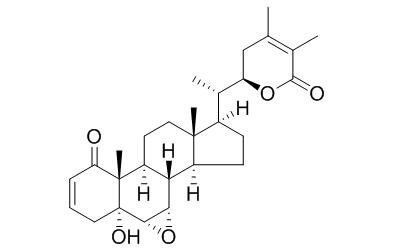Withanolide B
Reference standards.
Inquire / Order:
manager@chemfaces.com
Technical Inquiries:
service@chemfaces.com
Tel:
+86-27-84237783
Fax:
+86-27-84254680
Address:
1 Building, No. 83, CheCheng Rd., Wuhan Economic and Technological Development Zone, Wuhan, Hubei 430056, PRC
Providing storage is as stated on the product vial and the vial is kept tightly sealed, the product can be stored for up to
24 months(2-8C).
Wherever possible, you should prepare and use solutions on the same day. However, if you need to make up stock solutions in advance, we recommend that you store the solution as aliquots in tightly sealed vials at -20C. Generally, these will be useable for up to two weeks. Before use, and prior to opening the vial we recommend that you allow your product to equilibrate to room temperature for at least 1 hour.
Need more advice on solubility, usage and handling? Please email to: service@chemfaces.com
The packaging of the product may have turned upside down during transportation, resulting in the natural compounds adhering to the neck or cap of the vial. take the vial out of its packaging and gently shake to let the compounds fall to the bottom of the vial. for liquid products, centrifuge at 200-500 RPM to gather the liquid at the bottom of the vial. try to avoid loss or contamination during handling.
Plant Science2024, 338:111914
J of Apicultural Research2020, 10.1080
Plant Physiol Biochem.2023, 202:107913.
Molecules.2021, 26(6):1635.
Acta Chromatographica2021, 00960.
Sains Malaysiana2024, 53(2):397-408.
Br J Pharmacol.2018, 175(6):902-923
Food Funct.2024, 15(8):4262-4275.
Life (Basel).2023, 13(2):457.
J Chromatogr B Analyt Technol Biomed Life Sci.2019, 1113:1-13
Related and Featured Products
Appl Biochem Biotechnol. 2012 Oct;168(3):681-96.
Optimization of elicitation conditions with methyl jasmonate and salicylic acid to improve the productivity of withanolides in the adventitious root culture of Withania somnifera (L.) Dunal.[Pubmed:
22843063 ]
Adventitious root cultures derived from leaf derived callus of Withania somnifera (L.) Dunal were treated with methyl jasmonate and salicylic acid independently.
METHODS AND RESULTS:
Biomass accumulation, culture age, elicitation period, and culture duration were optimized for higher withanolides production in the two best-responding varieties collected from Kolli hills (Eastern Ghats) and Cumbum (Western Ghats) of Tamil Nadu, India. Between the two elicitors, salicylic acid (SA) improved the production of major withanolides (withanolide A, Withanolide B, withaferin A, and withanone) as well as minor constituents (12-deoxy withastramonolide, withanoside V, and withanoside IV) in the Kolli hills variety. Treatment of root biomass (11.70 g FW) on 30-day-old adventitious root cultures with 150 μM SA for 4 h elicitor exposure period resulted in the production of 64.65 mg g(-l) dry weight (DW) withanolide A (48-fold), 33.74 mg g(-l) DW Withanolide B (29-fold), 17.47 mg g(-l) DW withaferin A (20-fold), 42.88 mg g(-l) DW withanone (37-fold), 5.34 mg g(-l) DW 12-deoxy withastramonolide (nine fold), 7.23 mg g(-l) DW withanoside V (seven fold), and 9.45 mg g(-l) DW withanoside IV (nine fold) after 10 days of elicitation (40th day of culture) when compared to untreated cultures.
CONCLUSIONS:
This is the first report on the use of elicitation strategy on the significant improvement in withanolides production in the adventitious root cultures of W. somnifera.



